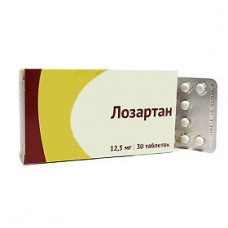Expiration date: 08/2025
Composition
1 tablet contains: losartan potassium 12.5 mg, 50 mg or 100 mg
Pharmacotherapeutic group
Angiotensin II receptor antagonist
Pharmacological action
Losartan is a specific antagonist of angiotensin II receptors (subtype AT1) for oral administration. Does not suppress kininase II, the enzyme that catalyzes the reaction of conversion of angiotensin I to angiotensin II. Angiotensin II selectively binds to AT1-receptors in many tissues (smooth muscle tissue of blood vessels, adrenal glands, kidneys and heart) and performs several important biological functions, including vasoconstriction and release of aldosterone. Angiotensin II also stimulates proliferation of smooth muscle cells. Losartan and its pharmacologically active metabolite (E 3174) as in vitro and in vivo block all physiological effects of angiotensin II, regardless of the source or route of synthesis. Losartan selectively binds to AT1-receptors and does not bind or block other hormone receptors and ion channels, playing an important role in the regulation of the function of the cardiovascular system. In addition, losartan does not inhibit angiotensin converting enzyme (ACE) - kininase II, and, accordingly, prevents the destruction of bradykinin, so side effects that are indirectly associated with bradykinin (e.g., angioedema) occur very rarely. When applying losartan, no effect of negative feedback on renin secretion leads to increased renin activity of blood plasma. Increased activity of renin leads to increased angiotensin II in blood plasma. However, antihypertensive activity and a decrease in the concentration of aldosterone in the blood plasma is preserved, indicating effective blockade of the angiotensin II receptor. Losartan and its active metabolite have a great affinity for receptors of angiotensin I than of angiotensin II receptors. The active metabolite is 10-40 times more active than losartan. After a single oral antihypertensive effect (reduced systolic and diastolic blood pressure (BP)) reaches a maximum after 6 hours, then for 24 hours gradually decreases. The maximum antihypertensive effect develops within 3-6 weeks after start of treatment. In patients with hypertension without concomitant diabetes mellitus with proteinuria (more than 2 g/day), the drug significantly reduces proteinuria, the excretion of albumin and immunoglobulin G. Stabilizes the concentration of urea in plasma. No effect on autonomic reflexes and has no lasting effects on the noradrenaline concentration in blood plasma. Losartan dose of 150 mg daily does not affect the concentration of triglycerides, total cholesterol and high density lipoprotein (HDL) in the blood serum in patients with arterial hypertension. In the same dose losartan does not affect the concentration of glucose in fasting blood.
Indications for use
Hypertension. Chronic heart failure (in combination therapy, intolerance or failure of therapy with angiotensin converting enzyme inhibitors). Reducing the risk of developing cardiovascular disease (including stroke) and mortality in patients with hypertension and left ventricular hypertrophy. Diabetic nephropathy or gipercreatininemia and proteinuria (ratio of urine albumin and creatinine to more than 300 mg/day) in patients with diabetes mellitus type 2 and concomitant arterial hypertension (reduction of progression of diabetic nephropathy to chronic renal insufficiency).
Contraindications
Hypersensitivity to drug, severe hepatic insufficiency (more 9 points on a scale child-Pugh), age 18 years, lactose intolerance, lactase deficiency or glucose-galactose malabsorption, pregnancy and lactation.
Method of application and doses
Inside, regardless of meals, the multiplicity of reception - 1 time per day. Pills proglatyvayut is not liquid, squeezed water. Hypertension the standard initial and maintenance dose for most patients is 50 mg 1 times/day. To achieve greater therapeutic effect, increase the dose to a maximum daily dose of 100 mg 1 time per day. The initial dose for patients with chronic heart failure is 12.5 mg 1 times per day. As a rule, the dose increases with weekly intervals (i.e. 12.5 mg/day 25 mg/day and 50 mg/day) to the average maintenance dose 50 mg 1 times a day, depending on tolerability by the patient.
Reducing the risk of developing cardiovascular disease (in
including stroke) and mortality in patients with hypertension and left ventricular hypertrophy - the initial dose is 50 mg 1 times/day. May be further added hydrochlorothiazide in low doses or increased dose of Losartan to 100 mg in single or two divided doses given reduction in blood pressure (BP). Protection of kidneys in patients with diabetes mellitus type 2 and proteinuria is the drug Losartan prescribed in the initial dose - 50 mg 1 time per day with further dose escalation to 100 mg/day (taking into account the degree of blood pressure reduction) in one or two doses. In patients with reduced BCC (for example, in the admission dioretikov at high doses) the recommended starting dose of Losartan is 25 mg 1 times/day. There is no need in the selection of the initial dose in patients with renal insufficiency, including patients on dialysis. No need for selection of dose in elderly patients, although it is recommended to start treatment with a dose of 25 mg in patients older than 75 years. Patients with liver disease in the anamnesis it is recommended to appoint drug in lower doses. The use of Losartan is contraindicated in patients with severe hepatic insufficiency, as there is no clinical experience in this patient group (see section "Contraindications"). The safety and efficacy of the drug in children under 18 years not installed.
Release form
Tablets of 12.5 mg, 50 mg and 100 mg 30 pills in a contour package



